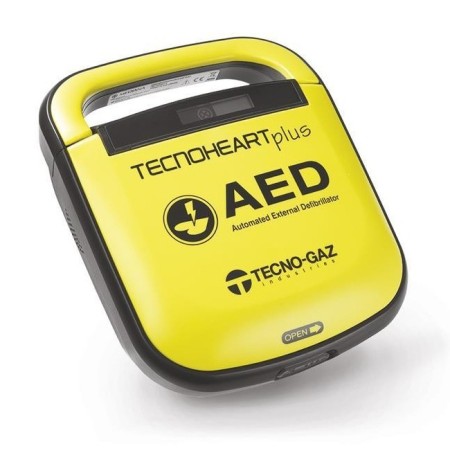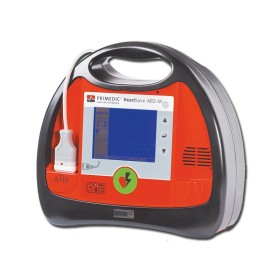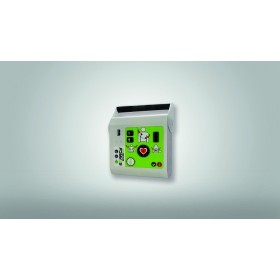per Kreditkarte, Paypal und Banküberweisung.
mit BRT-, DPD- und FedEx-Kuriern
per WhatsApp + 39.371.43.61.201
Tecnoheart Plus Defibrillator
- Hervorragende Einsatzbereitschaft
- Der ultimative Ausdruck von Duktilität sind automatisierte AED-Defibrillatoren.
- Diese Modelle verwalten alle Vorgänge autonom und informieren den Retter über die Aktivitäten, die das Gerät ausführt.
- Die Entladungen werden im HALBAUTOMATISCHEN Modus durch das Eingreifen des Bedieners nach mündlicher Warnung durch das System aktiviert.
Strategische Platzierung des Gerätes
Defibrillatoren so zu platzieren, dass sie leicht sichtbar und zugänglich sind, ist der erste Schritt zu einem effektiven und rechtzeitigen Eingreifen.
Verkürzen Sie die Zeit bis zur Verabreichung des ersten Schocks
- Das Ziel ist es, den ersten Schock innerhalb von 4 Minuten zu liefern.
- TecnoHeart Plus und seine Funktionen garantieren eine außergewöhnliche Einsatzbereitschaft.
Universeller Defibrillator
- Wahlschalter für Erwachsene und Kinder ohne Plattenwechsel
- Defibrillator, der in Übereinstimmung mit der Version 2010 der AHA/ERC-Richtlinien für Herz-Lungen-Wiederbelebung (CPR) und kardiovaskuläre Notfallbehandlung (ECC) entwickelt wurde.
Angeleitete vokale Interventionsverfahren
- Eine Stimme führt Sie durch den gesamten Eingriff.
Funktionen
- Deckel: Die Abdeckung dient zum Schutz der Aktionssymbole, der Patientenmodustaste und der Entlassungstaste.
- Statusanzeige: Die Statusanzeige zeigt den Status des Geräts, die Temperatur und den Akkustand an.
- Elektrodenanschluss: Der Elektrodenanschluss dient zum Anschluss der Elektroden.
- Aktionssymbole: Die LED Anzeige blinkt rot unter dem jeweiligen Aktionssymbol.
- Patientenmodus-Schalter: Sobald der Benutzer den Patienten nach Typ identifiziert hat, wählen Sie mit dem Patientenmodus-Schalter den Patientenmodus zwischen Erwachsenen und Pädiatrien aus.
- Entladetaste: Sobald die Vorbereitung auf den Stromschlag abgeschlossen ist, blinkt die Entladetaste. Drücken Sie die Entladetaste, um den Elektroschock abzugeben.
- Schiebeknopf: Der Schiebeknopf dient zum Öffnen des Deckels, zum Zünden den Schiebeknopf nach rechts drücken.
- SD-Kartensteckplatz: Die SD-Karte wird zum Speichern von Daten und zum Aktualisieren der AED-Firmware verwendet.
- Infrarot-Kommunikationsanschluss: Der Infrarot-Kommunikationsanschluss wird für die Kommunikation mit dem PC verwendet.
TECNOHEART DAS LEBENSRETTENDE GERÄT
• Sprachführer: für eine einfache und unterstützte Bedienung.
• SD-Karte: Archivierungstätigkeiten für den Rechtsschutz.
• Weiche Hülle: Schutz vor Stößen und Kratzern.
• Lange Lebensdauer der limno2-Batterie: 5 Jahre, 200 Entladungen.
• Batterieanzeige: Verstehen Sie immer den Batteriestand.
• Selbsttest kritischer Komponenten: ermöglichen die effiziente Aufrechterhaltung der Funktionalität der Geräte.
• Impedanzberechnung: Überprüfung der Integrität des AED-Kontakts mit dem Patienten.
• Display-Bildschirm: Hier können Sie die Anweisungen lesen, wenn Sie die Sprachanweisungen nicht hören können.
• Biphasischer Schock: eine elektrische Entladung, die das Herz zuerst in die eine und dann in die andere Richtung durchdringt.
• Heart-on-Software: Diese wird verwendet, um AED-Nutzungsdaten organisch zu speichern und Firmware-Updates zu ermöglichen.
• Vorgeschaltete Elektroden: Verkürzung der Eingriffszeiten
• Akku: 200 Stromschläge
• Irda-Kommunikationsanschluss: ermöglicht die Kommunikation zwischen PC und Defibrillator
• Variable Energie: Erwachsene (>25 kg) von 185 bis 200j Kind
WARUM EINEN DEFIBRILLATOR EINSETZEN?
- ETHIK: Ethik ist die Gesamtheit der objektiven und rationalen Grundlagen, die es ermöglichen, menschlichem Verhalten einen deontologischen Status zuzuweisen, d.h. es in gut, gerecht oder moralisch zulässig zu unterscheiden, im Gegensatz zu Verhaltensweisen, die als schlecht oder moralisch unangemessen angesehen werden. Ausgerüstet zu sein und lebensrettende Geräte zur Verfügung zu stellen, ist ein deontologisches Gebot, das über jede andere Bewertung hinausgeht.
- BEWUSSTSEIN: Der Begriff Bewusstsein bezieht sich auf die Wahrnehmung und kognitive Reaktion des Menschen auf das Eintreten eines bestimmten Ereignisses. Die Raten plötzlicher Todesfälle durch karidovaskolare Ursachen machen im Durchschnitt mehr als 50 % der gesamten Todesfälle aus.
- PFLICHT: Der Begriff Verpflichtung, der in der Alltagssprache als Synonym für Pflicht verwendet wird, hat im Recht eine spezifischere Bedeutung: Er bezeichnet die subjektive Rechtslage des Subjekts, das sich im Interesse anderer Subjekte in einer bestimmten, vom Gesetz auferlegten Weise verhalten muss. Der Besitz von lebensrettenden Geräten ist für viele Einrichtungen obligatorisch und ist "de facto" zu einer Pflicht für medizinische Gesundheitsbereiche geworden, in denen die Art der Berufsausübung die Bevölkerung einem kardiovaskulären Risiko aussetzt.
WAS IST EIN HERZSTILLSTAND?
Ein Herzstillstand ist ein plötzlicher Stillstand der Pumpfunktionen des Herzens, der zum Tod führt, wenn er nicht angemessen und umgehend behandelt wird.
Ein Herzstillstand kann verschiedene Ursachen haben, aber in den meisten Fällen ist er auf eine ischämische Herzerkrankung zurückzuführen.
Eine Person ist Opfer eines Herz-Kreislauf-Stillstands, wenn:
- bewusstlos ist;
-atmet nicht spontan (oder keucht);
-Der Puls an der Halsschlagader kann nicht erfasst werden.
Das Vorhandensein eines der beiden reicht aus, um die BLS-Sequenz (Basic Life Support) zu starten. Obwohl der Begriff
Herzstillstand wird oft als Synonym für plötzlichen Tod verwendet, besser ist es, den Begriff Herzstillstand zu verwenden, um sich auf den plötzlichen Verlust der Herzfunktion zu beziehen.
Tatsächlich können Herz-Lungen-Wiederbelebungsmanöver (CPR), wenn sie rechtzeitig und korrekt durchgeführt werden, den Herzstillstand umkehren und so das Leben des Patienten wiederherstellen.
Wir sprechen häufig von einem Herzstillstand, aber es wäre korrekter, von einem Herz-Kreislauf-Stillstand (ACR) zu sprechen, da die Atmungs- und Herz-Kreislauf-Funktionen eng miteinander verbunden sind und auf die Beendigung einer der beiden schnell die Stille der anderen folgt.
Tatsächlich folgt auf einen primitiven Kreislaufstillstand schnell ein Atemstillstand; Umgekehrt folgt auf eine Beendigung der Atemaktivität unweigerlich eine rasche Verschlechterung der Herzaktivität mit anschließendem Stillstand.
Auf einen plötzlichen Stillstand des Kreislaufs folgen innerhalb von 30-45 Sekunden Atemluft, Apnoe und das Einsetzen einer Pupillenerweiterung; Innerhalb von weiteren 45 Sekunden weiten sich die Pupillen vollständig.
Wenn das primäre Ereignis ein Atemstillstand ist, wird das Blut zunehmend sauerstoffarm und innerhalb weniger Minuten kommt es zu Asystolie oder Kammerflimmern mit der Folge zum Stillstand der Pumptätigkeit des Herzens.
Es ist daher verständlich, dass die Wiederbelebungsmaßnahmen für jeden dieser beiden Notfälle sowohl die Beatmung als auch die Durchblutung umfassen müssen.
ZEIT IST KRITISCH
Viele Studien haben gezeigt, wie wichtig die Zeit zwischen dem Moment des Kollapses und der Defibrillation ist und wie sich eine Herz-Lungen-Wiederbelebung (HLW), die von Umstehenden durchgeführt wird, auf das Überleben einer Person mit Kammerflimmern auswirkt.
Jede Minute, die zwischen Kollaps und Defibrillation liegt, verringert die Überlebenschancen von Opfern von Herzstillstand und Kammerflimmern um 7 bis 100 %, wenn keine Herz-Lungen-Wiederbelebung durchgeführt wird.
Kammerflimmern normalisiert sich selten von alleine.
Der Einsatz eines Defibrillators ist unerlässlich, um Leben zu retten.
Stellen Sie sicher, dass Sie eine zur Verfügung haben, wenn Sie sie brauchen.












